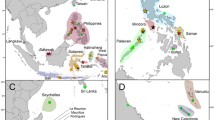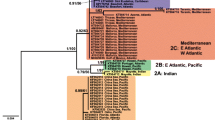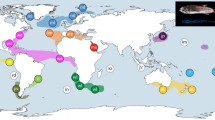Abstract
The upside-down jellyfish Cassiopea is a globally distributed, semi-sessile, planktonically dispersed scyphomedusa. Cassiopea occurs in shallow, tropical inshore marine waters on sandy mudflats and is generally associated with mangrove-dominated habitats. Controversy over the taxonomy of upside-down jellyfishes precedes their introduction to the Hawaiian Islands during the Second World War, and persists today. Here we address the global phylogeography and molecular systematics of the three currently recognized species: Cassiopea andromeda, C. frondosa, and C. xamachana. Mitochondrial cytochrome c oxidase I (COI) sequences from Australia, Bermuda, Fiji, the Florida Keys, the Hawaiian Islands, Indonesia, Palau, Panama, Papua New Guinea, and the Red Sea were analyzed. Highly divergent COI haplotypes within the putative species C. andromeda (23.4% Kimura 2-parameter molecular divergence), and shared haplotypes among populations of two separate putative species, C. andromeda and C. xamachana from different ocean basins, suggest multiple anthropogenic introductions and systematic confusion. Two deeply divergent O’ahu haplotypes (20.3%) from morphologically similar, geographically separate invasive populations indicate long-term (14–40 million years ago) reproductive isolation of phylogenetically distinct source populations and cryptic species. Data support at least two independent introductions to the Hawaiian Islands, one from the Indo-Pacific, another from the western Atlantic/Red Sea. Molecular phylogenetic results support six species: (1) C. frondosa, western Atlantic (2) C. andromeda, Red Sea/western Atlantic/Hawaiian Islands (3) C. ornata, Indonesia/Palau/Fiji (4) Cassiopea sp. 1, eastern Australia (5) Cassiopea sp. 2, Papua New Guinea and (6) Cassiopea sp. 3, Papua New Guinea/Hawaiian Islands.



Similar content being viewed by others
References
Agassiz A, Mayer AG (1899) Acalephs from the Fiji Islands. Bull Mus Comp Zool 32:157–189
Arai MN (2001) Pelagic coelenterates and eutrophication: a review. Hydrobiologia 451:68–87
Baldwin B, Robichaux RH (1995) Historical biogeography and ecology of the Hawaiian silversword alliance (Asteraceae): new molecular phylogenetic perspectives. In: Wagner WL, Funk VA (eds) Hawaiian biogeography: evolution on a hot spot archipelago. Smithsonian Institution Press, Washington, pp 259–287
Bowers N, Stauffer JR, Kocher TD (1994) Intra- and interspecific mitochondrial DNA sequence variation within two species of rock-dwelling cichlids (Teleostei: Cichlidae) from Lake Malawi, Africa. Mol Phylogenet Evol 3:75–82
Buckley TR, Simon C, Chambers GK (2001) Phylogeography of the New Zealand cicada Maoricicada campbelli based on mitochondrial DNA sequences: ancient clades associated with Cenozoic environmental change. Evolution 55:1395–1407
Bucklin A, Bentley AM, Franzen SP (1998) Distribution and relative abundance of the copepods, Pseudocalanus moultoni and P. newmani, on Georges Bank based on molecular identification of sibling species. Mar Biol 132:97–106
Caccone A, Sbordoni V (2001) Molecular biogeography of cave life: a study using mitochondrial DNA from bathysciine beetles. Evolution 55:122–130
Carlton JT (1989) Man’s role in changing the face of the ocean: biological invasions and implications for conservation of nearshore environments. Conserv Biol 265–273
Carranza S, Arnold EN, Mateo JA, Geniez P (2002) Relationships and evolution of the North African geckos, Geckonia and Tarentola (Reptilia: Gekkonidae), based on mitochondrial and nuclear DNA sequences. Mol Phylogenet Evol 23:244–256
Castilla JC, Collins AG, Meyer CP, Guiñez R, Lindberg DR (2002) Recent introduction of the dominant tunicate, Pyura praenuptialis (Urochordata, Pyuridae) to Antofagasta, Chile. Mol Ecol 11:1579–1584
Collin R (2000) Phylogeny of the Crepidula plana (Gastropoda: Calyptraeidea) cryptic species complex in North America. Can J Zool 78:1500–1514
Crandall KA, Bininda-Emonds ORP, Mace GM, Wayne RK (2000) Considering evolutionary processes in conservation biology. Trends Ecol Evol 15:290–295
Cywinska A, Hebert PDN (2002) Origins and clonal diversity in the hypervariable asexual ostracod Cypridopsis vidua. J Evol Biol 15:134–145
Dawson MN (2003) Macro-morphological variation among cryptic species of the moon jellyfish, Aurelia (Cnidaria: Scyphozoa). Mar Biol 143:369–379. Erratum. Mar Biol 144:203
Dawson MN, Jacobs DK (2001) Molecular evidence for cryptic species of Aurelia aurita (Cnidaria, Scyphozoa). Biol Bull 200:92–96
Doty MS (1961) Acanthophora, a possible invader of the marine flora of Hawai’i. Pac Sci 15:547–552
Eldredge LG, Carlton JT (2002) Hawaiian marine bioinvasions: a preliminary report. Pac Sci 56:211–212
Felsenstein J (1985) Confidence limits on phylogenies: an approach using the bootstrap. Evolution 39:783–791
Fleck J, Fitt WK (1999) Degrading leaves of Rhizophora mangle Linné provide a natural cue for settlement and metamorphosis of the upside down jellyfish Cassiopea xamachana. J Exp Mar Biol Ecol 234:83–94
Flowers JM, Schroeter SC, Burton RS (2002) The recruitment sweepstakes has many winners: genetic evidence from purple sea urchins. Evolution 56:1445–1453
Folmer O, Black M, Hoeh W, Lutz R, Vrijenhoek R (1994) DNA primers for amplification of mitochondrial cytochrome c oxidase subunit I from diverse metazoan invertebrates. Mol Mar Biol Biotech 3:294–299
Funk DJ (1999) Molecular systematics of cytochrome oxidase I and 16S from Neochlamisus leaf beetles and the importance of sampling. Mol Biol Evol 16:67–82
Gohar HAF, Eisawy AM (1960) The biology of Cassiopea andromeda (from the Red Sea) (With a note on the species problem). Publ Mar Biol Stat Ghardaqa 11:3–39
Gómez A, Snell TW (1996) Sibling species in the Brachionus plicatilis species complex. J Evol Biol 9:953–964
Gómez A, Serra M, Carvalho GR, Lunt DH (2002) Speciation in ancient cryptic species complexes: evidence from the molecular phylogeny of Brachionus plicatilis. Evolution 56:1431–1444
Haeckel EHPA (1880) Das system der medusen: erster theil einer monographie der medusen. Fischer, Jena
Hart MW, Byrne M, Smith MJ (1997) Molecular phylogenetic analysis of life-history evolution in asterinid starfish. Evolution 51:1846–1859
Hebert PDN, Cywinska A, Ball SL, de Waard JR (2003) Biological identifications through DNA barcodes. Proc R Soc Lond B 270:313–322
Herke SW, Foltz DW (2002) Phylogeography of two squid (Loligo pealei and L. plei) in the Gulf of Mexico and northwestern Atlantic Ocean. Mar Biol 140:103–115
Hofmann DK, Hadfield MG (2002) Hermaphroditism, gonochorism, and asexual reproduction in Cassiopea sp.—an immigrant in the islands of Hawai‘i. Invertebr Reprod Dev 41:215–221
Holland BS (2000) Genetics of marine bioinvasions. Hydrobiologia 420:63–71
Holland BS, Hadfield MG (2002) Islands within an island: phylogeography and conservation genetics of the endangered Hawaiian tree snail Achatinella mustelina. Mol Ecol 11:365–376
Hummelinck PW (1968) Caribbean scyphomedusae of the genus Cassiopea. studies of fauna of Curaçao and other Caribbean Islands 23:1131–1143
Jordal BH, Normark BB, Farell BD, Kirkendall LR (2002) Extraordinary haplotype diversity in haplodiploid inbreeders: phylogenetics and evolution of the bark beetle genus Coccotrypes. Mol Phylogenet Evol 23:171–188
Knowlton N (2000) Molecular genetic analyses of species boundaries in the sea. Hydrobiologia 420:73–90
Knowlton N, Weigt LA (1998) New dates and new rates for divergence across the Isthmus of Panama. Proc R Soc Lond B 265:2257–2263
Kramp PL (1970) Zoogeographical studies on Rhizostomae (Scyphozoa). Vidensk Medd Dan Naturhist Foren Khobenhavn 133:7–30
Lessios HA (1998) The first stage of speciation as seen in organisms separated by the Isthmus of Panama. In: Howard DJ, Berlocher SH (eds) Endless forms: species and speciation. Oxford University Press, New York, pp 186–201
Mallet J (2001) The speciation revolution. J Evol Biol 14:887–888
Mayer AG (1906) Medusae of the Hawaiian Islands collected by the steamer Albatross in 1902. Bull US Fish Comm 23:1131–1143
Mayr E, Ashlock PD (1993) Principles of systematic zoology, 2nd edn. McGraw-Hill, New York, N.Y.
Meyer A, Knowles LL, Verheyen E (1996) Widespread geographical distribution of mitochondrial haplotypes in rock-dwelling cichlid fishes from Lake Tanganyika. Mol Ecol 5:341–350
Meyran JC, Monnerot M, Taberlet P (1997) Taxonomic status and phylogenetic relationships of some species of the genus Gammarus (Crustacea, Amphipoda) deduced from mitochondrial DNA sequences. Mol Phylogenet Evol 8:1–10
Mills CE (2001) Jellyfish blooms: are populations increasing globally in response to changing ocean conditions? Hydrobiologia 451:55–68
O’Foighil D, Gaffney PM, Wilbur AE, Hilbish TJ (1998) Mitochondrial cytochrome oxidase I gene sequences support an Asian origin for the Portuguese oyster Crassostrea angulata. Mar Biol 131:497–503
Palumbi SR (1997) Molecular biogeography of the Pacific. Coral Reefs 16:47–52
Peek AS, Gaut BS, Feldman RA, Barry JP, Kochevar RE, Lutz RA, Vrijenhoek RC (2000) Neutral and nonneutral mitochondrial genetic variation in deep-sea clams from the family Vesicomyidae. J Mol Evol 50:141–153
Rundell RJ, Holland BS, Cowie RC (2004) Molecular Phylogeography of the endemic Hawaiian Succineidae (Gastropoda: Pulmonata). Mol Phylogenet Evol 31:246–255
Sax DF (2001) Latitudinal gradients and geographic ranges of exotic species: implications for biogeography. J Biogeogr 28:139–150
Tarr CL, Fleischer RC (1995) Evolutionary relationships of the Hawaiian honeycreepers (Aves: Drepanidae). In: Wagner WL, Funk VA (eds) Hawaiian biogeography: evolution on a hot spot archipelago. Smithsonian Institution Press, Washington, pp 147–159
Tautz D, Arctander P, Minelli A, Thomas RH, Vogler AP (2003) A plea for DNA taxonomy. Trends Ecol Evol 18:70–74
Templeton AR (1989) The meaning of species and speciation: a genetic perspective. In: Otte D, Endler JA (eds) Speciation and its consequences. Sinauer, Sunderland, Mass., pp 3–27
Thiel VME (1975) Bemerkungen zur Systematik der Gattung Cassiopea (Cepheida, Scyphomedusae). Mitt Hamb Zool Mus Inst 72:25–46
Trewick SA, Wallis GP, Morgan-Richards M (2000) Phylogeographical pattern correlates with Pliocene mountain building in the alpine scree weta (Orthoptera, Anostostomatidae). Mol Ecol 9:657–666
Uchida T (1970) Occurrence of a rhizostome medusa, Cassiopea mertensii Brandt from the Hawaiian Islands. Annot Zool Jpn 43:102–104
Williams ST (2000) Species boundaries in the starfish genus Linckia. Mar Biol 136:137–148
Acknowledgements
We are grateful to Professor Mike Hadfield for providing support and research facilities at the Kewalo Marine Laboratory, University of Hawai’i, and to Professor John Benzie for facilities at the Centre for Marine and Coastal Studies, University of New South Wales (UNSW). We thank William Puleloa, Tom Iwai, Lori Colin, Bert Hoeksema, Harilaos Lessios, Don de Maria, Laura Martin, David Miller, Kylie Pitt, Alan Nelson, Kirk Murakami, and Dan Lindstrom for providing medusae specimens. Thanks to Kualoa Ranch and Mid-Pacific Golf Course for providing access. François Seneca assisted in laboratory DNA extractions. Thanks to Dr. Jonathan Gardner, Victoria University, New Zealand for valuable comments on an earlier draft of this manuscript. We also thank Aquarium Solutions International, Ruhr-Universität Bochum, and the Vice-Chancellor’s Post-doctoral Fellowship scheme (UNSW) for financial support. The experiments performed during the course of this study are in full compliance with the current laws of the United States.
Author information
Authors and Affiliations
Corresponding author
Additional information
Communicated by P.W. Sammarco, Chauvin
Rights and permissions
About this article
Cite this article
Holland, B.S., Dawson, M.N., Crow, G.L. et al. Global phylogeography of Cassiopea (Scyphozoa: Rhizostomeae): molecular evidence for cryptic species and multiple invasions of the Hawaiian Islands. Marine Biology 145, 1119–1128 (2004). https://doi.org/10.1007/s00227-004-1409-4
Received:
Accepted:
Published:
Issue Date:
DOI: https://doi.org/10.1007/s00227-004-1409-4




